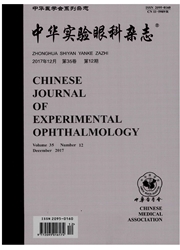

 中文摘要:
中文摘要:
背景目前玻璃体内注射雷珠单抗是治疗湿性年龄相关性黄斑病变(wAMD)的主流方法之一,疗效较好,但对于晚期黄斑下瘢痕形成,但仍存在活动性病灶的wAMD眼是否需要抗血管内皮生长因子(VEGF)治疗存在争议。目的探讨黄斑中心凹下已瘢痕化但尚存在活动性病灶的晚期wAMD患者行抗VEGF治疗的疗效及临床意义。方法对2013年2月至2015年5月在云南省第二人民医院诊疗的晚期wAMD患者89例89眼的临床资料进行回顾性分析,其中接受玻璃体腔注射雷珠单抗治疗的患者68例作为治疗组,仅接受临床观察而不接受任何治疗的21例患者作为未治疗组。治疗组患者按照玻璃体腔注射的标准方法,遵循3+prn原则进行每个月1次,连续注射3次的雷珠单抗玻璃体腔注射方案,所有患者随访6~24个月。采用ETDRS视力表比较患者治疗前后最佳矫正视力(BCVA);采用彩色眼底照相和荧光素眼底血管造影(FFA)观察患眼眼底表现;采用OCT检查患眼视网膜活动性病灶消退情况,包括视网膜下液的吸收情况、中心视网膜厚度(CRT)变化及黄斑中心凹下瘢痕形成情况;了解患者对视功能改善认可度的主观评价。对2个组间上述指标的结果进行比较。结果治疗组患者在随访期间每眼平均注射(4.1±1.2)次。治疗组和未治疗组患者随访末BCVA均较初始视力明显提高,2个组间患者在不同时间点BCVA总体比较差异无统计学意义(P〉0.05)。治疗组68例患者中随访末期BCVA提高者占69.12%,明显高于未治疗组的28.58%,差异有统计学意义(P=0.016)。治疗组68眼在治疗过程中视网膜下液均逐渐消失,而未治疗组21眼中视网膜下及视网膜积液吸收者7眼,随访期间视网膜下及视网膜无变化者8眼,积液增加者6眼。治疗组患眼CRT平均厚度减少了(220.16±34.76)μm,未治疗组平均减少(101?
 英文摘要:
英文摘要:
Background Intravitreal injection of ranibizumab is a primary approach to the treatment of wet age-related macular degeneration (wAMD) ,but whether it is necessary for wAMD with subfoveal scarring and active lesion to receive the intravitreal injection of ranibizumab is in dispute. Objective This study was to evaluate the possible therapeutic effect of intravitreal injection of ranibizumab on wAMD with subfoveal scarring and active lesion. Methods The clinical data of the patients with wAMD with subfoveal scarring and active lesion were retrospectively analyzed,including 89 eyes of 89 eases who received diagnoses and treatments in Second Hospital of Yunnan Province from February 2013 to May 2015. Sixty-eight patients who received intravitreal injections of ranibizumab were treated group,and 21 patients who received clinical observations only served as the untreated group. Intravitreal injection of ranibizumab was carried out following the 3 +prn principle,and all of the patients were followed-up for 6-24 months. Best corrected visual acuity (BCVA) of the patients were examined with ETDRS chart. The fundus findings was examined by fundus color photography and fundus fluoresceinangiography ( FFA). The subjective assessment of visual improvements was obtained from each patient, and the recession of retinal active lesions was assessed by OCT, including the absorbing state of subretinal fluid, the change of central retinal thickness (CRT) and subfoveal scarring. Results The mean injection times were (4. 1± 1.2) for each eye. The BCVA at the end of following-up was evidently improved in both groups, and no significant difference was found among various time points ( P〉0. 05 ). However, the patient rate of BCVA improvement was 69. 12% in the treated group,which was signnificantly higher than 28.58% of the untreated group (P = 0. 016). In the treated group, subretinal fluid was gradually absorbed in all eyes in the treating duration, however,in the untreated group,the fluid was completely
 同期刊论文项目
同期刊论文项目
 同项目期刊论文
同项目期刊论文
 期刊信息
期刊信息
